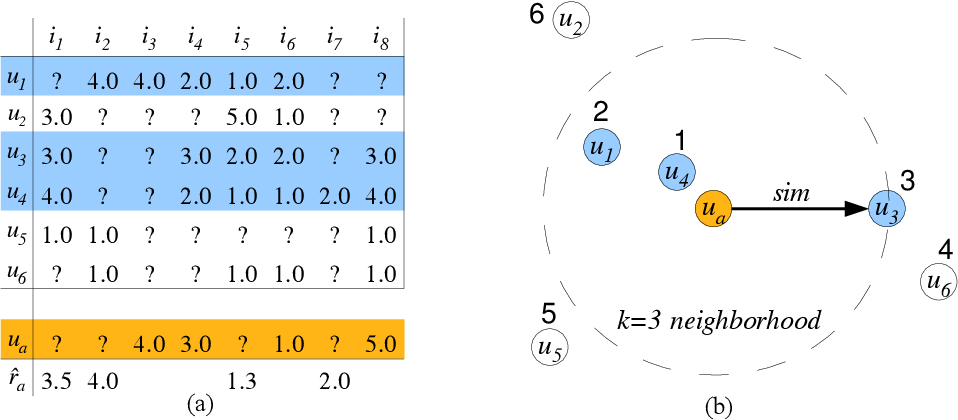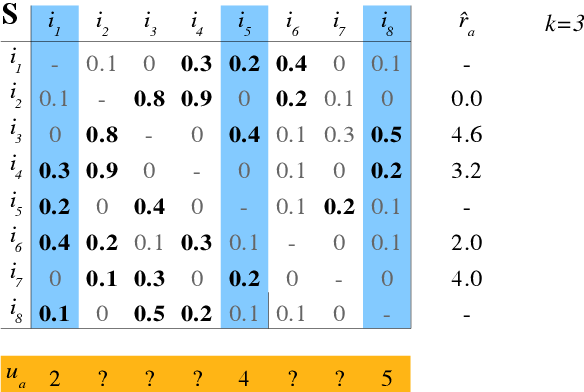tags: R recommenderlab Recommendation System 推薦系統
recommenderlab套件介紹
推薦系統基本觀念—Collaborative Filtering(協同式過濾)
1. User-based Collaborative Filtering(UBCF)
Memory-based CF
- 採用「全部」或巨量的使用者資料去進行推薦→佔記憶體
- 推薦系統通常是在線上進行運算,因此上述特性會不利於演算速度
原理
- 假設:擁有相似偏好的人會對項目有相似的評分標準。
- 從與 \(u_a\) 相似的 \(k\) 個( \(k=3\) )鄰居( \(u_4 , u_1 , u_3\) )的評分紀錄中計算出(e.g.平均) \(u_a\) 的缺失項目( \(i_1 , i_2 , i_5, i_7\) )評分,進而取前幾高 \(\hat{r}_a\) 做推薦。
- 如何計算相似度?
- Pearson Correlation Coefficient
- 即統計學常用之相關係數:r
- 公式:
- Cosine Similarity
- 計算各點之間的Cosine角度,角度愈小欲相似。
- 公式:
- Pearson Correlation Coefficient
- 如何找出鄰居(Neighborhood)?
- KNN(k-nearest-neighbors)演算法:以新點為中心距離K個最近的點中,哪種類別最多即為該類別。
- 給定一個Similarity Threshold值來選出相似的人
- 計算 \(u_a\) 的評分( \(\hat{r_a}\) ):
- 簡易版公式:
- 加權版公式:
- 鑑於在 \(k\) 人之中,仍有與 \(u_a\) 距離的差異,因此需增加權重(Weights)
- \(S_a\) 為 \(u_a\) 和 \(u_i\) (\(i\) within \(k\) neighbors) 的相似度
- 移除個人評分上的偏誤(為了讓每個user的評分權重一樣):
- Normalization(常態化):Z-score
- Center the row:
2. Item-based Collaborative Filtering(IBCF)
Model-based CF
- 採用部分的(Reduced Similarity Matrix by \(k\))使用者資料去學習一個Compact Model
- 因為模型小( \(n\) x \(k, k ≪ n\) ),較有效率
- 應用上可以完全地達成預先運算(fully precomputed)
原理
- 假設:喜歡i品項的人也會喜歡與i品項有相似的特徵的項目。
- 將 \(u_a\) 有的評分( \(i_1 , i_5, i_8\) )與Similarity Matrix前 \(k\) 高( \(k=3\) )的評分矩陣拿去做加權總和(Weighted Sum),算出 \(u_a\) 其他缺失項目的評分,並取前幾高的 \(\hat{r}_a\) 做推薦。
- Similarity Matrix:
- 計算評分的公式:
- 移除個人評分偏誤的方法同UBCF
Other model-based approaches
I. Slope One algorithm (Lemire and Maclachlan 2005)
II. Latent Factors approach using matrix decomposition (Koren, Bell, and Volinsky 2009)
3. Using 0-1 Data
真實情境
- 我們拿到的資料有很大的機率都是Binary的資料(有/無購買商品),不一定都有Ratings
- 我們不知道消費者沒有購買商品,是因為哪種情況?
- 不需要
- 不知情
- 不喜歡
推薦演算法的因應作法
網站流量資料中,我們只知道該頁面是否被預覽的資訊(Binary Data)
- 1:使用者喜歡此項目(非缺失項目)
- 0:使用者不喜歡此項目/使用者不知道此項目存在(缺失項目)
因此在0-1 Case中,
- 缺點:非缺失項目全部都是1,將無法計算Pearson correlation或Cosine similarity
- 解方:使用Jaccard index
- 另一種Similarity的衡量方式(只專注在1的情況)
- \(,\) where X and Y are the sets of the items with a 1 in user profiles \(u_a\) and \(u_b,\) respectively.
基於關聯規則(Association Rules)的0-1 Data
- 與IBCF相似(使用條件機率similarity)
- 可以預先運算
- 關聯規則的重要評估指標:
- \(support(X → Y) = support(X ∪ Y) = Freq(X ∪ Y)/|D| = \hat{P}(E_X ∩ E_Y)\)
- \(confidence(X → Y)=support(X ∪Y)/support(X)=\hat{P}(E_Y|E_X)\)
應用於推薦系統上
- 找出所有匹配 \(X → Y, X ⊆ T_a\) 的規則
- 推薦N個獨一(unique)、擁有最高 \(confidence\) 的 \(right-hand-sides (Y)\)規則
4. 評估方法
1. 評估預測評分值(Ratings)
-
MAE:
-
RMSE:
2. 評估Top-N的推薦
- 混淆矩陣(Confusion Matrix)
| actual \ predicted | negative | positive |
|---|---|---|
| negative | a (TN) | b (FP) |
| positive | c (FN) | d (TP) |
- Accuracy: \(,\frac{TP+TN}{Total}\)
- MAE: \(,\frac{TP+FN}{Total}\)
- Precision: \(,\frac{TP}{TP+FP}\)
- Recall: \(,\frac{TP}{TP+FN}\)
- E-measure:\(, α\) controls the trade-off between precision and recall.
- F-measure:
recommenderlab的功能
1. 建立資料
- 資料轉換
as(data, "realRatingMatrix"):模型使用
- 查看資料
getRatingMatrix(data):取得矩陣內容as(data, "list"):推薦的items可以用list查看as(data, "data.frame"):用data frame的形式查看
2. 移除評分偏誤
normalize(data):Center the row- 會使極端評分(只評0分和5分)、中性評分(都評2~3分)的人變得沒有差別
normalize(data, method="Z-score"):Z-score- 若想保留不同user的評分級距資訊,使用此法較合理(平均數為0,標準差為1)
denormalize(data):還原常態化
3. 視覺化評分資料分佈
image(data, main="Title")
4. 製作0-1 Data
binarize(data, minRating)- 設定 ≥ minRating 以上的評分為1,其餘為0
5. 模型製作與預測
查看所有推薦演算法
recommenderRegistry$get_entries(dataType = "realRatingMatrix")
建立一般模型
Recommender(data, method)
建立驗證模型
evaluationScheme(data, method="split", train, given, goodRating)- method:
- split:切割train/test資料
- train:設定training data的比例
- cross:交叉驗證
- k:做k回交叉驗證
- split:切割train/test資料
- given:數字(要放入幾個items訓練模型)
- 每個user有多個items的評分,given決定模型在看了n個評分後,就去猜unknown items的評分。
- 由於訓練時會保留了一些known data,因此可以計算error。
- 若填入負數,表示扣除該數字,放入全部的資料(all-but-n)。
- goodRating:一種threshold,決定多少以上算是好的評分。
- method:
evaluate(scheme, method="POPULAR", type = "topNList", n=c(1,3,5,10,15,20))- 可以取代predict的功能,直接幫你跑完結果。
- 一次做top-1, top-3, …到top-20的模型。
預測模型
predict(model, newData, type)- model:做完Recommender(data, method)之後的變數。
- type:評分方式
- topN, ratings, … 依據不同model方法而不同。
- 可以用
names(getModel(model))查看。
- type選擇使用topN時,可直接省略type,並設定n:直接選擇predict n個結果。
bestN(predict, n):選取TopN中最高的n個。
評估模型
calcPredictionAccuracy(predict, unknowData):計算RMSE/MSE/MAEgetConfusionMatrix(evaluate)[[1]]:計算TP/FP/FN/TN/precision/recall/TPR/FPRavg(evaluate):看平均的表現
範例Demo
Jester線上笑話推薦系統
- 5000份匿名評分資料
- 1999年4月到2003年5月
1. 讀取資料
2. 敘述性統計
rowCounts():user總共評價幾筆資料rowMeans():user的平均評分
我們發現資料有很大的評分偏誤:
多數人評價了70筆或全部的笑話:
平均評分的分數接近左偏的常態分佈:
3. 移除評分偏誤
4. 比較模型與表現評估
- ROC曲線(TPR vs FPR)
- 對於ROC曲線,我們希望找到TPR高且FPR低的點(左上角),代表猜對的多、猜錯的少
- 但這兩者剛好是一個trade-off,不能兩全其美
- 因此可依據domain knowledge去決定應選擇何種組合
上圖的線為不同的推薦演算法;數字代表推薦TopN個商品。
隨著推薦個數(TopN)愈多,TPR和FPR皆會上升(猜得愈多,猜中/猜錯的次數都會變大)。
結論:UBCF表現最佳且遠高於Based line的Random演算法(亂猜,機率0.5)。
- Precision vs Recall
- 評估Ratings
透過互動式App感受推薦系統的樣貌→ ShinyApp by Michael Hahsler.


























